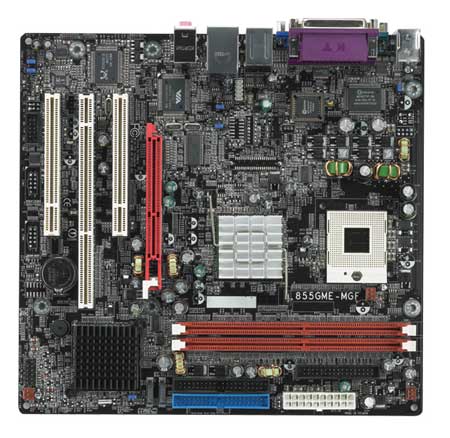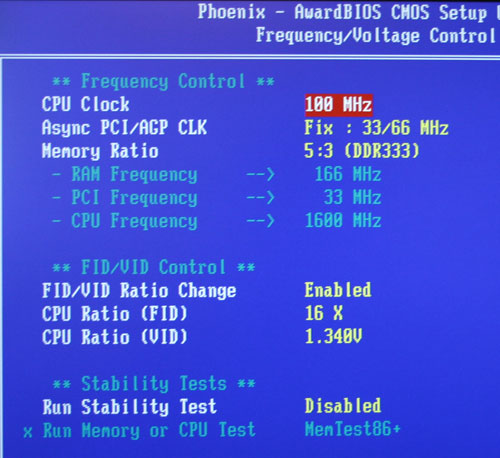Intel's Pentium M on the Desktop - A Viable Alternative?
by Anand Lal Shimpi on February 7, 2005 4:00 PM EST- Posted in
- CPUs
DFI 855GME-MGF
The DFI 855GME-MGF was originally designed for a customer who needed PCI-X support, so DFI used a server version of ICH5 that provided both PCI-X and SATA support (FWE6300ESB). The server ICH obviously contributes to the price of the board, but from what we've seen, the DFI board only commands a $10 price premium over the AOpen board.
Since it's based on the 855GME chipset, the board obviously features integrated video - but the performance is nothing to write home about. Unlike AOpen's board, there's only a single 10/100/1000 GigE port, but on the 855GME-MGF, you get a single FireWire 400 port on the I/O panel as well (instead of through a separate connector).
The 855GME-MGF only needs a 20-pin ATX power connector and no auxillary 4-pin +12V connector (unlike the AOpen board). The problem with DFI's layout, however, is the placement of a capacitor next to the 20-pin ATX power connector, which means that you can't use a 24-pin PSU with the board unless you have an adapter as the capacitor that won't let the additional 4 pins overhang.
The BIOS of the 855GME-MGF is very similar to the AOpen board in terms of options, but the actual layout for overclocking in the BIOS isn't as intuitive as it was on the AOpen board.

The stability of the DFI board was nothing to complain about, although it was far more sensitive to memory overclocking than the AOpen board was. When overclocked to the same levels that we were able to achieve on the AOpen board, the 855GME-MGF would randomly not POST between reboots. Usually a quick reboot would fix the problem, but it's still something that we'd rather not deal with. While we could easily hit 2.4GHz on the AOpen board, we found that 2.26GHz was the only stable overclock that we could achieve on the DFI motherboard (with all other variables, such as memory speed, the same).
The voltage adjustments are equally as disappointing on the 855GME-MGF. You can only adjust Vcore up to a maximum of 1.340V. And just like the AOpen board, although the 855GME-MGF only officially supports the 400MHz FSB, reaching 533MHz isn't a problem at all.
DFI's cooling solution is a little different from AOpen's, as they include a smaller but taller heatsink that screws on to a backplate. Both DFI and AOpen's fans were similarly quiet. AOpen's heatsink relied on thermal grease to improve heat transfer, while DFI's solution has a layer of thermal conductive material already on the base of the heatsink. The advantage to AOpen's method of just supplying thermal grease is that it's easier to reapply if you switch CPUs often, rather than the material that's present on the DFI heatsink.
Overall, the DFI is just as capable of a board as AOpen's solution, and is the only solution that offers a PCI-X slot if that matters to you. However, the BIOS layout, reduced stability when overclocking, and a slightly higher price point give the nod to AOpen for our overall recommendation.
The DFI 855GME-MGF currently sells for $239.










77 Comments
View All Comments
bob661 - Tuesday, February 8, 2005 - link
The only problem with this chip is that the marketing is oriented towards the mobile market and therefore not a direct competitor to the A64. It would be nice if it was. It might bring some cats out of the bag on the AMD side. Competition in the marketplace is good for us all.jvrobert - Tuesday, February 8, 2005 - link
Really, AMDroids, get a grip. You're all excited because the AMD chips beat a mobile processor pretty handily, and because you are making some silly assumption that the Pentium-M in its current form is Intel's "last chance".First, Intel doesn't need a last chance. They make enough money to make AMD look like a Mexico City taco stand. So enough of those delusions of grandeur.
But on a technical front, if Intel ramps the clockspeed up to the 2.8 range (easy), and releases a desktop class chipset for the Pentium M it would match or exceed any current chip. And these are _basic_ steps. What if they made more improvements?
jvrobert - Tuesday, February 8, 2005 - link
bob661 - Tuesday, February 8, 2005 - link
#45You are a rock. The point of the article was to compare the P-M to desktop CPU's because most of us here wanted to know it will perform. And you know what? It performed very nicely.
classy - Tuesday, February 8, 2005 - link
I just can't help but to laugh at some folks. Its a nice chip but clearly not in the A64 ballpark. Its that simple. As far as the 2.8 oc, that was only accomplished in one reveiw. All the reviews show the same thing you have oc so it can it compete. What's interesting though is most of these Intel fanboys don't want to see a comparison of an oc'ed A64 vs a Dothan. Smoke city :)FrostAWOL - Tuesday, February 8, 2005 - link
IF the Pentium-M and P4 are electrically incompatible then someone please explain this:HP Blade system Pentium-M with Serverworks GC-SL chipset
http://h18000.www1.hp.com/products/servers/prolian...
FrostAWOL
jae63 - Tuesday, February 8, 2005 - link
Great review & of interest to those of us with HTPCs. Too bad the price point is so steep.One minor correction on page 11:
"The Pentium M does a bit better in the document creation tests, as they are mostly using applications that will fit within the CPU's cache. However, the introduction of a voice recognition program into the test stresses the Pentium M's floating point performance, which does hamper its abilities here."
Actually NaturallySpeaking uses almost no floating point but is very memory intensive. The performance hit that you are seeing is because it uses a lot of memory bandwidth and its dataset doesn't fit in the L2 cache.
Here's some support for my statement, by the main architect of NaturallySpeaking, Joel Gould:
http://tinyurl.com/6s4mh
segagenesis - Tuesday, February 8, 2005 - link
#43 - I think you have the right idea here. This processor is not meant to be performance busting but rather a low energy alternative to current heat factories present inside every P4 machine. I would love to have this in a HTPC machine myself but the cost is still too damn high. Hopefully higher production will bring the cost down.Aileur - Tuesday, February 8, 2005 - link
I guess the pentium M isnt ready (yet) for a full featured gaming machine, but with that kind of power, passively cooled, it would make for one hell of an htpc.PrinceGaz - Tuesday, February 8, 2005 - link
#45- It was not an unfair review, on the contrary it seemed very well done. The reason the P-M was compared with fast P4 and A64's is because they cost about the same.Maybe someone else buys your computers for you, but most of us here have to spend our own money on them so cost is the best way to decide what to compare it with.